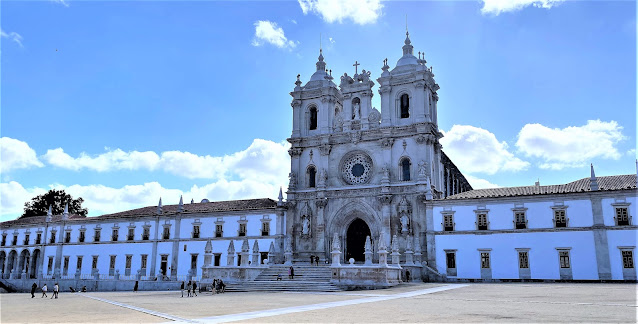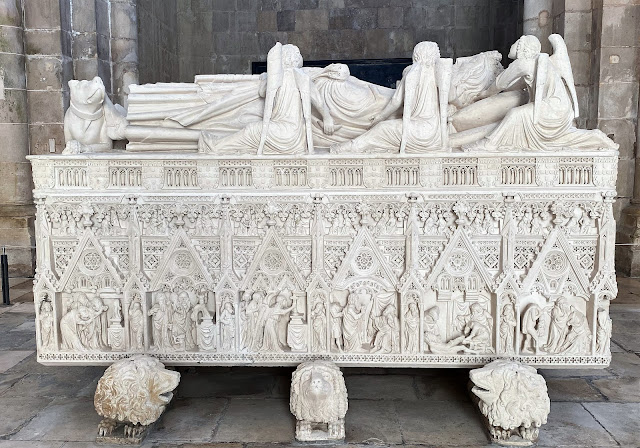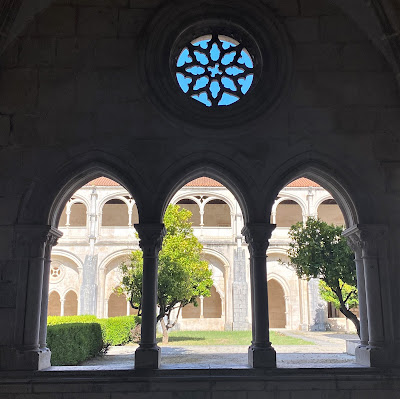June 27, 2022
Our first stop of the day was only a seven-mile drive from Nazaré--the city of Alcobaça, and more specifically, the Monastery of Santa Maria. The church that is the centerpiece of the monastery was built by order of the first king of Portugal to commemorate a victory over the Moors in 1147 and as a gift for the Cistercian Order (a Benedictine branch) under Bernard of Clairvaux. It took 76 years to complete the cathedral, and another 60 or so to add on the cloister. They are the first Gothic buildings in Portugal, and the church itself was the largest in Portugal at the time of its completion (and still is). The complex was named a UNESCO World Heritage Site in 1989.
The central church facade dates to 1702.
The interior was completed in 1269. The church was consecrated for the monks and the public was not permitted to enter until the 18th century.
The dramatic nave is over 325 feet long.
The best things in the monastery are the twin tombs of Pedro I of Portugal (called both "Pedro the Just" and "Pedro the Cruel"), who died in 1367, and his mistress, Inês de Castro. The story of their affair is a little long, but worth your time.
Pedro was married off to Constanza in a politically advantageous union, but when she arrived, Pedro fell in love with her lady-in-waiting, Inês, the daughter of a prominent aristocratic family. Pedro and Constanza were married in 1340, and she died in childbirth in 1349. Meanwhile, Pedro carried on with Inês. Pedro's father (the king) tried to marry him off again after Constanza's death, but Pedro refused, and the king refused to let him marry Inês, so the lovers lived together in secret. Some sources believe they were secretly married in 1354.
Pedro's fatal mistake was that he began to give Inês's brothers prominent positions in court. The king feared this would lead to civil war after his death, so in 1355 he sent three men to Inês to "take care" of the problem. They found her in a monastery in Coimbra and decapitated her in front of one of her children. Pedro revolted against his father, but was put down quickly. Nevertheless, when the king died a year later, Pedro ascended to the throne.
Legend has it that in 1361 Pedro tracked down the three assassins, conducted a public trial that found them guilty of Inês's murder, and ripped out their hearts with his own hands to reflect what they had done to his heart. He then had Inês's body exhumed (six years after her death), dressed in queenly robes and jewels, and placed on the throne. His vassals then lined up to kiss the hand of the queen.
Pedro had two tombs constructed, one for each of them, and placed in the monastery. The tombs were placed facing each other so that he and Inês would see each other when they rose on Judgment Day, and the words "Until the end of the world" were inscribed in Portuguese in the marble. Pedro lived almost 12 years after the assassination of his beloved, never remarrying.
Inês is clothed in a queen's robe and has a crown on her head. She is being tenderly cradled by six angels. The tomb rests on the rather gruesome carvings of Inês's assassins--half man, half beast. The carvings on the sides of the marble tomb represent scenes from the Old Testament, the life and death of Christ, and the final judgment.
It's hard to believe these charming angels were carved in the 14th century. They have a very modern look. I'd like one of these on my grave, please.
The carving at the head of Inês's tomb depicts the crucifixion of Christ.
The carvings on Pedro's tomb narrate the life of St. Bartholomew, the King's patron saint.
Close-up of one of the lion-head supports for Pedro's tomb.
One end of Pedro's tomb shows Bartholomew healing the sick.

The other end is a classic Wheel of Life, with the inner and outer circles depicting his relationship with Inês.
On the left below we have St. Anthony of Lisbon and Padua, Patron Saint of the Poor and Lost Things (as in his poor hairstyle choice). On the right below, holding his customary keys, is St. Peter, Patron Saint of Fisherman (which makes sense) and Those with Foot Ailments (which doesn't).
Another depiction of St. Anthony includes God the Father and the Holy Spirit.
I love this statue of "Maria," the church's namesake, from the 18th century. She has a tender gaze, a graceful carriage, and beautiful clothes. But she is so EUROPEAN, isn't she? Nothing Middle-eastern here.
Another lovely Maria statue is in the "Holy Sacrament" room. I also like the muted Last Supper painting behind Mary. Information at the site notes that the statue of
"the Mother of God [is] part of an altar-piece constructed in the chancel during the 16th-18th centuries but removed in 930. The cistercian monks would show their trust in Her by singing the song "Hail to the Queen" (Salve Regina) in the evening."The entrance to the sacristy has quit an incredible ceiling constructed in the 16th century.
We went out to the cloister next, and I think it is one of the most beautiful I have seen. It didn't hurt that there was a brilliant azure sky highlighting all the cloister's best features.
A Renaissance fountain where monks could wash their hands before meals sits within a Gothic fountain niche in the cloister.
This gorgeous room looks a lot like mosque to me, but it is the refectory where the monks would hold meetings and perhaps eat their meals.
It even has what to me looks like a minbar--the place where the imam stands to deliver sermons--but it is the pulpit from which the abbot taught.
Another fascinating room is the monastery kitchen, built in the 18th century. The kitchen workers were responsible for feeding almost 1,000 monks.
These must be sinks.
Great spigot on the left and a view from the kitchen on the right.
Until I came back and started to do some research, I thought this room was some kind of a sauna, not a kitchen. Water is brought into the kitchen from a canal system on the outside.
A massive chimney covered in glazed tiles sits in the middle of the room.
This room with its golden light and Moorish arches is both beautiful and a little frightening at the same time. It was originally the monks' dormitory. I could see this room being used as the set for a horror movie.
More images that could belong in a scary movie:
A statue of Our Lady of Fatima, a very Portuguese icon, is in another niche, along with paintings of two of the three children to whom she appeared. More about her in a future post.
The Room of the Kings is lined with 17th- and 18th-century statues of Portuguese kings, and the walls are decorated with 18th century tiles that depict the history of the Monastery.
One more tile wall, just because I am obsessed with them.
Back outside as we made our way to our next destination, we noticed a random castle ruin on the hill--not something you see every day where we come from.








.JPG)
.JPG)



.JPG)
.JPG)
.JPG)
.JPG)
.JPG)

















.JPG)




.JPG)






This was truly a "wow" site. The story of Ines and Pedro is something else. Ines deserves to have a funky angel massaging her bones.
ReplyDelete